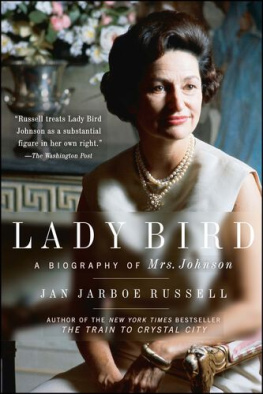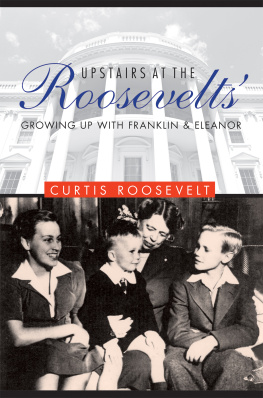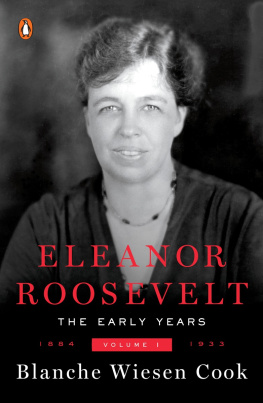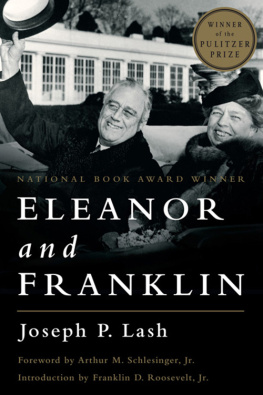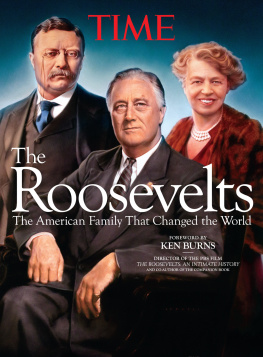All rights reserved. No part of this publication may be reproduced, stored in a retrieval system, or transmitted, in any form or by any means, electronic, mechanical, photocopying, recording, or otherwise, without the prior written permission of the publisher. Printed in the United States of America.
Text design by Tonya Hahn.
Set in 10-point Utopia by Perseus Publishing Services.
A CIP record for this book is available from the Library of Congress.
Preface
W ith the passing years, Eleanor Roosevelt rises higher in the publics estimation as the countrys preeminent First Lady. Historian James MacGregor Burns, in his magisterial The American Experiment (1989), singles out Mrs. Roosevelt as his one hero of social change, praising her for political wisdom, concern for the downtrodden, internationalism, and crusading for womens rights.
Other First Ladies have made substantial contributions to the nations cultural and political life. But it is difficult to find another who comes close to matching Eleanor Roosevelts sheer energy and diversity of interests. She was a dynamo.
Mrs. Roosevelt produced at least five hundred words for every My Day column and often more, six days per week, with virtually no interruptions, for nearly twenty-six years (19361962). Never a great prose stylist, she required the help of her loyal secretaries to clean up, type, and transmit the My Day columns by wire or phone to United Feature Syndicate in New York. Eleanor Roosevelt had the good fortune to be blessed with a high energy and chronic insomnia: She often wrote My Day in bed at the end of a packed sixteen-hour day.
My Day was not Eleanor Roosevelts only regular column; she wrote for magazines as well. Nor was she simply a journalist. She wrote or coauthored numerous books, countless speeches, and hundreds of letters. One of her children, remarking on the frustration their mother must have felt when palsy eventually made it impossible for her to hold a pen, said she had been the writingest woman alive.
No activity, work, or subject was too humble to gain Eleanor Roosevelts attention. No glittering gala event with royalty or famous entertainers was too sophisticated for her tastes. From one day to the next, readers watched Mrs. Roosevelt shift, for example, from gardening at her beloved Hyde Park, New York, cottage to negotiating as chairman of the United Nations Committee on Human Rights. She found as much fascination in child rearing as in visiting a foreign capital.
My Day columns from 1936 through April 1945 show us Mrs. Roosevelt as First Lady during her husband Franklins four terms as President. FDR, hampered by polio, sent his wife into the country and the world many times to be his eyes and ears. She reported back with an astute sense of the nations social and political needs. During the Depression Eleanor Roosevelt went to the coal mines, the Dust Bowl farming communities, and the ghettos as well as to universities, factories, and highsociety events. She was First Lady to all the people. A pacifist at heart with a clear-headed realism concerning international affairs, she had been tempered by the disaster of World War I and its failed diplomatic aftermath. The onset of a second global conflict in the late 1930s dismayed her. Her own sons enlisted for the war effort after the Japanese attacked Pearl Harbor in 1941, and Mrs. Roosevelt suffered anxiety and relief about their travels and homecomings as did countless other American mothers.
In My Day we see Mrs. Roosevelt recovering from the shock of the Presidents death (April 1945) and, with surprising quickness, finding her own way as a widowed working woman. President Harry Truman asked her to serve as a delegate to the United Nations; eventually she chaired the Committee on Human Rights. By 1952, when Truman left the White House, Eleanor Roosevelts official standing at the UN was over, although in subsequent years her work as an interested citizen in support of the UN occupied a large share of her time. When Adlai Stevensons campaign for the presidency failed, despite Mrs. Roosevelts support, 1952 marked the end of the long Democratic control of the Executive Branch. That year also saw the beginning of the painfully slow truce negotiations in the Korean conflict. Throughout this period, Mrs. Roosevelt inveighed against the scourge of Red-baiting and McCarthyism.
As the Presidents wife, Eleanor Roosevelt had been generally circumspect in expressing her opinions, letting loyalty to the Presidents programs override her natural tendencies as gadfly. With the President gone, she took off the padded gloves, becoming an indefatigable, outspoken fighter for a whole rainbow of causes, many of them far from popular.
Eleanor Roosevelt, it was said, typified... the realization of the dreams of the female Crusaders of the 19th century who threw off the restrictions of the Victorian age. So began one obituary for Mrs. Roosevelt in November 1962. She lived to be seventy-eight but had time to acknowledge her advanced age only in her last few weeks. Otherwise she lived with an intensity that left many younger relatives, co-workers, and friends breathless.
A longtime advocate of civil rights, Mrs. Roosevelt had some dramatic gestures to her credit. She resigned from the Daughters of the American Revolution because the group refused to let the black contralto Marian Anderson sing in Washingtons Constitution Hall. She resigned from New Yorks fashionable Colony Club because it refused to consider a Jewish friend for membership. She used My Day to promote desegregation as it gained important momentum in the 1950s through Supreme Court decisions, the work of Dr. Martin Luther King, Jr., and congressional equal rights legislation.
Americas role in the world during the cold war was a frequent My Day topic. Like most Americans Eleanor Roosevelt took seriously the threat of Communist attack from abroad. But rather than arming America to the teeth, Mrs. Roosevelt tried to build bridges of friendship with the Soviets, visiting the Kremlin, interviewing Khrushchev, and even having him to tea in her New York apartmentwhere, it was reported by a secretary, she gave him a piece of her mind. There were occasional attacks on her character and ideas by right-wing groups who claimed she was a Communist pinko herself, and there was even a threat on her life. She shrugged it all off.
Mrs. Roosevelt was the quintessential grandmother, though some biographers say she was less than an ideal mother. Late in her life it was hard for her to keep track of all the grandchildren, great-grandchildren, cousins and their children, nieces and nephewsbut she did an admirable job. The good fortunes and failures of her own offspring were largely kept out of My Day, but there is a sweet dose of reminiscing about jolly days with her children when the family had time to vacation and play together.



